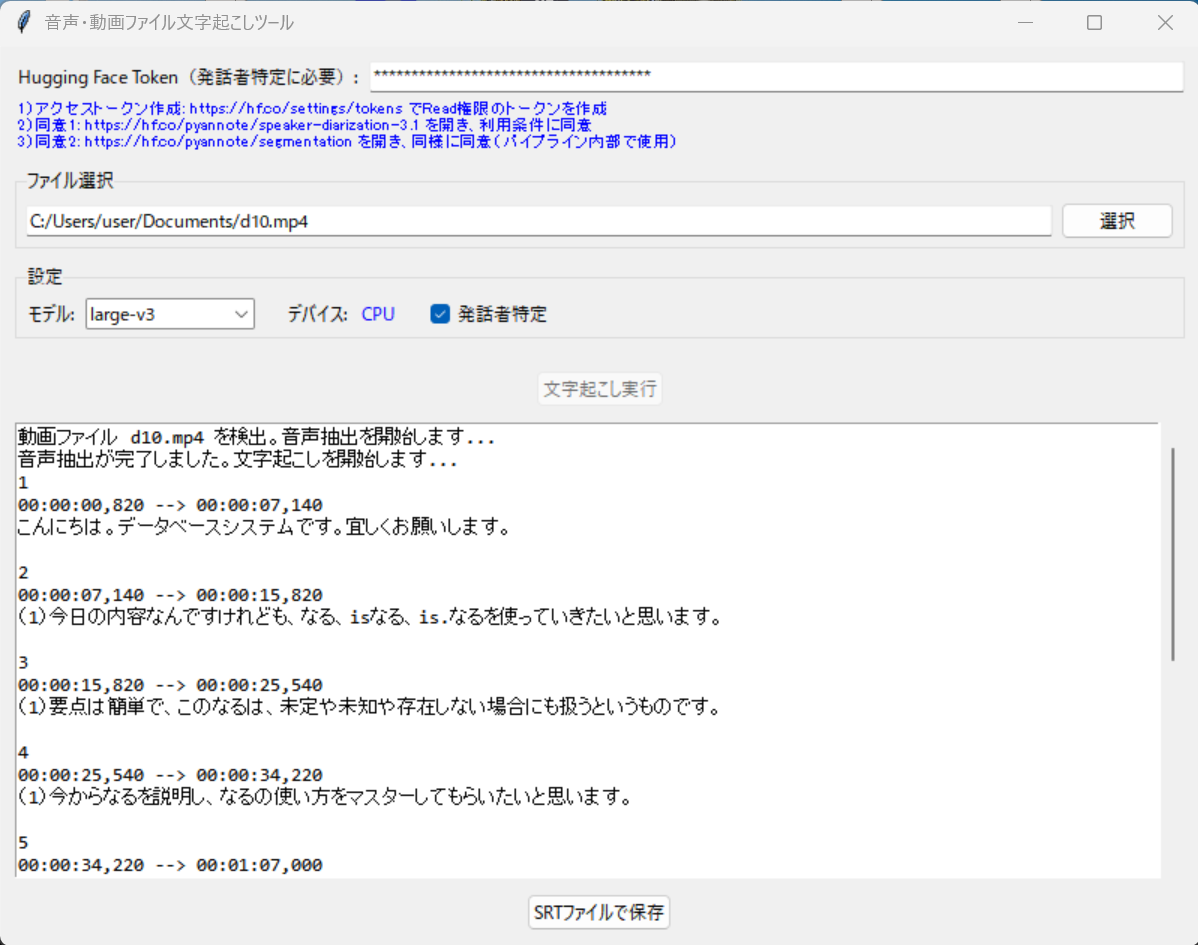OpenAI Whisperによる日本語の音声・動画ファイル文字起こし・pyannoteによる話者特定
【概要】OpenAI Whisperを使用して音声・動画ファイルをテキストに変換する。Windows環境での実行手順、プログラムコード、実験アイデアを含む。

事前準備
Python 3.12 と Windsurf(AIエディタ)のインストールコマンド
まだインストールしていない場合の手順である(インストール済みの人は実行不要)。
管理者権限で起動したコマンドプロンプト(手順:Windowsキーまたはスタートメニュー > cmd と入力 > 右クリック > 「管理者として実行」)。で以下を実行
winget install --scope machine --id Python.Python.3.12 -e --silent
winget install --scope machine --id Codeium.Windsurf -e --silent
set "INSTALL_PATH=C:\Program Files\Python312"
echo "%PATH%" | find /i "%INSTALL_PATH%" >nul
if errorlevel 1 setx PATH "%PATH%;%INSTALL_PATH%" /M >nul
echo "%PATH%" | find /i "%INSTALL_PATH%\Scripts" >nul
if errorlevel 1 setx PATH "%PATH%;%INSTALL_PATH%\Scripts" /M >nul
set "NEW_PATH=C:\Program Files\Windsurf"
if exist "%NEW_PATH%" echo "%PATH%" | find /i "%NEW_PATH%" >nul
if exist "%NEW_PATH%" if errorlevel 1 setx PATH "%PATH%;%NEW_PATH%" /M >nul
Windows での FFmpeg インストール手順(手動インストール)
公式ビルド版を使用
-
ダウンロード
- https://www.gyan.dev/ffmpeg/builds/ にアクセス
- 「release builds」セクションの「full」版をダウンロード
- ファイル名例:
ffmpeg-release-full.7z - essentials版ではなくfull版を選択(ffprobeも含まれる)
- ファイル名例:
-
解凍
- ダウンロードした7zファイルを右クリック
- 7-Zip等で解凍(Windows標準では7z非対応のため、7-Zipが必要)
- 7-Zipダウンロード: https://www.7-zip.org/
- 解凍先を
C:\ffmpegにする(推奨)- フォルダ構造:
C:\ffmpeg\bin\ffmpeg.exeとなるように配置
- フォルダ構造:
-
環境変数PATHの設定
- Windowsキー + R → 「sysdm.cpl」と入力してEnter
- 「詳細設定」タブ → 「環境変数」ボタンをクリック
- 「システム環境変数」の「Path」を選択 → 「編集」
- 「新規」をクリック →
C:\ffmpeg\binを追加 - 「OK」を3回クリックして設定を保存
-
動作確認
- コマンドプロンプトを新規で開く(既存のものは閉じる)
- 以下のコマンドを実行:
ffmpeg -version ffprobe -version - バージョン情報が表示されれば成功
必要なライブラリのインストール
管理者権限で起動したコマンドプロンプト(手順:Windowsキーまたはスタートメニュー > cmd と入力 > 右クリック > 「管理者として実行」)。で以下を実行
pip install -U torch torchvision torchaudio --index-url https://download.pytorch.org/whl/cu126
pip install openai-whisper transformers sounddevice numpy
HugggingFace トークン取得
https://huggingface.co/settings/tokens にアクセス. HugggingFace トークンの設定.保存の支援ツールは別ページ (https://www/kkaneko.jp/ai/labo/hf.html)で紹介.
プログラムコード
# OpenAI Whisperによる日本語の音声・動画ファイル文字起こし・pyannoteによる話者特定
import sys
import os
import threading
import time
from pathlib import Path
import tkinter as tk
from tkinter import filedialog, messagebox, scrolledtext, ttk
import torch
from faster_whisper import WhisperModel
import torchaudio
import subprocess
import tempfile
# 対応ファイル形式
VIDEO_EXTENSIONS = {'.mp4', '.avi', '.mov', '.mkv', '.flv', '.m4v'}
AUDIO_EXTENSIONS = {'.wav', '.mp3', '.aac', '.ogg', '.wma', '.flac', '.webm', '.3gp'}
SUPPORTED_EXTENSIONS = VIDEO_EXTENSIONS | AUDIO_EXTENSIONS
# 文の終端として扱う記号(結合の判定に使用)
END_PUNCTUATIONS = ('。', '!', '?', '.', '!', '?')
# 結合の上限(長すぎを回避)
MAX_MERGE_DURATION_S = 30.0
MAX_MERGE_CHARS = 150
def detect_best_device():
"""最適なデバイスを自動検出"""
if torch.cuda.is_available():
return "cuda", "float16"
else:
return "cpu", "int8"
def format_srt_timestamp(seconds: float) -> str:
"""SRT形式のタイムスタンプに変換(丸め誤差に強い)"""
total_ms = int(round(seconds * 1000))
hours, rem = divmod(total_ms, 3600 * 1000)
minutes, rem = divmod(rem, 60 * 1000)
secs, millis = divmod(rem, 1000)
return f"{hours:02d}:{minutes:02d}:{secs:02d},{millis:03d}"
class TranscriptionGUI:
def __init__(self, root):
self.root = root
self.root.title("音声・動画ファイル文字起こしツール")
self.root.geometry("800x600")
self.auto_device, self.auto_compute_type = detect_best_device()
self.model = None
self.setup_gui()
def setup_gui(self):
main_frame = ttk.Frame(self.root, padding="10")
main_frame.pack(fill=tk.BOTH, expand=True)
self.token_frame = ttk.Frame(main_frame)
self.token_frame.pack(fill=tk.X, pady=(0, 10))
self.token_frame.columnconfigure(1, weight=1)
token_label = ttk.Label(self.token_frame, text="Hugging Face Token(発話者特定に必要):")
token_label.grid(row=0, column=0, sticky=tk.W, padx=(0, 5))
self.hf_token = tk.StringVar()
token_entry = ttk.Entry(self.token_frame, textvariable=self.hf_token, show="*")
token_entry.grid(row=0, column=1, sticky=tk.EW)
token_info_text = (
"1) アクセストークン作成: https://hf.co/settings/tokens でRead権限のトークンを作成\n"
"2) 同意1: https://hf.co/pyannote/speaker-diarization-3.1 を開き、利用条件に同意\n"
"3) 同意2: https://hf.co/pyannote/segmentation を開き、同様に同意(パイプライン内部で使用)"
)
token_info_label = ttk.Label(self.token_frame, text=token_info_text, font=("", 8), foreground="blue", justify=tk.LEFT)
token_info_label.grid(row=1, column=0, columnspan=2, sticky=tk.W, pady=(4, 0))
file_frame = ttk.LabelFrame(main_frame, text="ファイル選択", padding="5")
file_frame.pack(fill=tk.X, pady=(0, 10))
self.file_path = tk.StringVar()
ttk.Entry(file_frame, textvariable=self.file_path, width=60).pack(side=tk.LEFT, padx=(0, 5), fill=tk.X, expand=True)
ttk.Button(file_frame, text="選択", command=self.select_file).pack(side=tk.LEFT)
model_frame = ttk.LabelFrame(main_frame, text="設定", padding="5")
model_frame.pack(fill=tk.X, pady=(0, 10))
ttk.Label(model_frame, text="モデル:").pack(side=tk.LEFT)
self.model_var = tk.StringVar(value="medium")
ttk.Combobox(
model_frame, textvariable=self.model_var,
values=["tiny", "base", "small", "medium", "large-v3", "large-v3-turbo"],
state="readonly", width=15
).pack(side=tk.LEFT, padx=(5, 20))
ttk.Label(model_frame, text="デバイス:").pack(side=tk.LEFT)
device_text = "GPU (CUDA)" if self.auto_device == "cuda" else "CPU"
ttk.Label(model_frame, text=device_text, foreground="blue").pack(side=tk.LEFT, padx=(5, 20))
self.speaker_diarization = tk.BooleanVar(value=False)
ttk.Checkbutton(model_frame, text="発話者特定", variable=self.speaker_diarization).pack(side=tk.LEFT)
self.transcribe_button = ttk.Button(main_frame, text="文字起こし実行", command=self.start_transcription)
self.transcribe_button.pack(pady=10)
self.result_text = scrolledtext.ScrolledText(main_frame, height=20, wrap=tk.WORD, font=("Consolas", 10))
self.result_text.pack(fill=tk.BOTH, expand=True, pady=(0, 10))
self.context_menu = tk.Menu(self.result_text, tearoff=0)
self.context_menu.add_command(label="コピー", command=lambda: self.result_text.event_generate("<<Copy>>"))
self.context_menu.add_separator()
self.context_menu.add_command(label="すべて選択", command=lambda: self.result_text.tag_add("sel", "1.0", "end"))
self.result_text.bind("<Button-3>", self.show_context_menu)
ttk.Button(main_frame, text="SRTファイルで保存", command=self.save_result).pack()
def show_context_menu(self, event):
"""右クリックメニューを表示し、選択状態に応じて「コピー」を有効/無効化"""
try:
self.result_text.get("sel.first", "sel.last")
self.context_menu.entryconfig(0, state=tk.NORMAL)
except tk.TclError:
self.context_menu.entryconfig(0, state=tk.DISABLED)
self.context_menu.tk_popup(event.x_root, event.y_root)
def select_file(self):
filetypes = [("対応ファイル", " ".join(f"*{ext}" for ext in SUPPORTED_EXTENSIONS)), ("すべて", "*.*")]
filename = filedialog.askopenfilename(title="音声・動画ファイルを選択", filetypes=filetypes)
if filename:
self.file_path.set(filename)
def update_result(self, text: str):
def _update():
self.result_text.insert(tk.END, text)
self.result_text.see(tk.END)
self.root.after(0, _update)
def start_transcription(self):
file_path = self.file_path.get()
if not file_path or not os.path.exists(file_path):
messagebox.showerror("エラー", "有効なファイルを選択してください")
return
self.transcribe_button.config(state="disabled")
self.result_text.delete(1.0, tk.END)
threading.Thread(target=self.transcribe_worker, daemon=True).start()
def transcribe_worker(self):
audio_file_to_process = None
temp_wav_file = None
try:
original_file_path = self.file_path.get()
file_ext = Path(original_file_path).suffix.lower()
if file_ext in VIDEO_EXTENSIONS:
self.update_result(f"動画ファイル {Path(original_file_path).name} を検出。音声抽出を開始します...\n")
temp_wav_file = tempfile.mktemp(suffix=".wav")
command = [
"ffmpeg", "-y", "-i", original_file_path,
"-vn", "-ar", "16000", "-ac", "1", "-f", "wav", temp_wav_file
]
proc = subprocess.run(command, capture_output=True, text=True, encoding='utf-8', errors='ignore')
if proc.returncode != 0:
error_message = proc.stderr or f"ffmpegがエラーコード {proc.returncode} で終了しました。"
self.update_result(f"音声抽出に失敗しました: {error_message}\n")
return
self.update_result("音声抽出が完了しました。文字起こしを開始します...\n")
audio_file_to_process = temp_wav_file
else:
audio_file_to_process = original_file_path
model_size = self.model_var.get()
want_diarization = self.speaker_diarization.get()
token = self.hf_token.get().strip()
self.model = WhisperModel(model_size, device=self.auto_device, compute_type=self.auto_compute_type)
diarization = None
if want_diarization and token:
try:
from pyannote.audio import Pipeline
pipeline = Pipeline.from_pretrained("pyannote/speaker-diarization-3.1", use_auth_token=token)
if torch.cuda.is_available():
pipeline.to(torch.device("cuda"))
diarization = pipeline(audio_file_to_process)
except Exception as e:
self.update_result(f"注: 発話者特定をスキップした(理由: {str(e)})\n")
elif want_diarization and not token:
self.update_result("注: トークン未入力のため発話者特定をスキップした\n")
segments_gen, _ = self.model.transcribe(
audio_file_to_process, language="ja", beam_size=5, temperature=0.0,
condition_on_previous_text=True,
initial_prompt="以下は日本語の音声である。文は意味のまとまりで区切り、適切に句読点「、」「。」を付ける。",
vad_filter=True,
vad_parameters=dict(min_silence_duration_ms=2800, speech_pad_ms=400, max_speech_duration_s=3600.0),
)
srt_index, buf_text, buf_start, buf_end = 0, "", None, None
def pick_speaker_id(start, end):
if not diarization: return None
mid = (start + end) / 2.0
for turn, _, speaker in diarization.itertracks(yield_label=True):
if turn.start <= mid <= turn.end:
try: return str(int(speaker.split("_")[-1]) + 1)
except: return None
return None
def flush():
nonlocal srt_index, buf_text, buf_start, buf_end
if not buf_text: return
srt_index += 1
speaker_id = pick_speaker_id(buf_start, buf_end)
line_text = f"({speaker_id}){buf_text}" if speaker_id else buf_text
srt_entry = f"{srt_index}\n{format_srt_timestamp(buf_start)} --> {format_srt_timestamp(buf_end)}\n{line_text}\n\n"
self.update_result(srt_entry)
buf_text, buf_start, buf_end = "", None, None
for seg in segments_gen:
text = (seg.text or "").strip()
if not text: continue
if buf_start is None: buf_start = seg.start
buf_end, buf_text = seg.end, buf_text + text
if text.endswith(END_PUNCTUATIONS) or (buf_end - buf_start) >= MAX_MERGE_DURATION_S or len(buf_text) >= MAX_MERGE_CHARS:
flush()
if buf_text: flush()
except Exception as e:
self.update_result(f"エラー: {str(e)}\n")
finally:
if temp_wav_file and os.path.exists(temp_wav_file):
try:
os.remove(temp_wav_file)
except OSError as e:
self.update_result(f"注: 一時ファイルの削除に失敗しました: {e}\n")
self.root.after(0, self.transcription_finished)
def transcription_finished(self):
self.transcribe_button.config(state="normal")
def save_result(self):
content = self.result_text.get(1.0, tk.END).strip()
if not content:
messagebox.showwarning("警告", "保存する内容がありません")
return
filename = filedialog.asksaveasfilename(defaultextension=".srt", filetypes=[("SRT字幕ファイル", "*.srt")])
if filename:
with open(filename, 'w', encoding='utf-8') as f: f.write(content)
messagebox.showinfo("完了", "SRTファイルで保存しました")
def main():
root = tk.Tk()
app = TranscriptionGUI(root)
root.mainloop()
if __name__ == "__main__":
main()
使用方法
- 上記のコードを whisper_transcribe.py として保存する
- コマンドラインで実行する:
python whisper_transcribe.py
モデルサイズの選択と特徴
プログラム内の load_model() で指定するモデルサイズを変更することで、認識精度と処理速度の違いを体験できる。各モデルの特徴は以下の通りである:
- tiny:39MB、低精度だが高速処理が可能
- base:74MB、中程度の精度で高速処理が可能
- small:244MB、中程度の精度で標準的な処理速度
- medium:769MB、高精度で標準的な処理速度
- large:1550MB、最高精度だが低速処理
体験・実験のアイデア
- 異なるモデルサイズで、結果を比較する
- 雑音のある環境での音声認識性能を検証する
- 早口や方言での認識能力を実験する
![[kaneko lab.]](https://www.kkaneko.jp/info/logo_png.png)